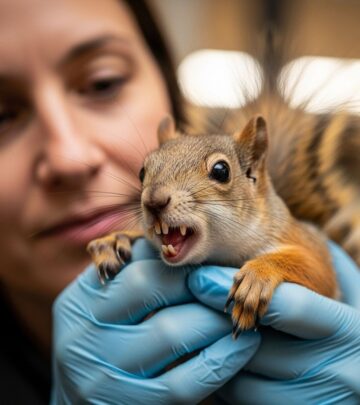Why Do Hamsters Play Dead? Nature’s Clever Survival Trick
Spot subtle stress signals early and create a tranquil habitat for your tiny furred friend.

Image: HearthJunction Design Team
Hamsters: Masters of Playing Dead
Hamsters are among the most popular small pets worldwide, beloved for their round bodies and friendly demeanor. Yet, anyone who has kept a hamster may be both startled and confused to discover their usually lively companion lying still, apparently lifeless in its cage. This remarkable act isn’t a spontaneous tragedy — it’s a natural, deeply ingrained survival behavior known as thanatosis, or playing dead.
Understanding the Drama: What Is Thanatosis?
The term thanatosis describes the elaborate pretense of death that certain animals display when faced with danger. In the wild, this can mean the difference between life and death. Hamsters, though domesticated for decades, maintain this primal behavior from their ancestors, serving as a trick to avoid predators who prefer not to eat something already dead.
- Thanatosis is an involuntary state where the animal becomes immobile and sometimes appears to stop breathing.
- Trigger: It is typically triggered by acute fear, extreme stress, or sudden environmental shock.
- Duration: The state can last from a few minutes to several hours, depending on the animal’s sense of safety.
This “playing dead” is not unique to hamsters; it’s found in reptiles, birds, mammals, and even some insects. Yet, in hamsters, the act is particularly convincing — and alarming to their human caregivers.
The Evolutionary Purpose: Why Fake Death?
To understand why hamsters resort to this behavior, consider the vast, predator-rich environments their wild ancestors inhabited. When threatened, running isn’t always an option, especially for small, slow-to-escape creatures like hamsters. Therefore, feigning death became a survival adaptation.
- Predatory Aversion: Many predators are instinctively averse to eating dead prey, as it could be diseased or spoiled. By appearing unresponsive, the hamster tricks the predator into losing interest.
- Escape Opportunity: Some predators will loosen their grip or lower their guard around immobile prey, giving the hamster a split-second chance to escape.
- Self-Defense: Thanatosis is usually a last-resort strategy when fight or flight is impossible.
Not Just Hamsters: Thanatosis in the Animal Kingdom
While hamsters are notorious for this behavior in captivity, many other animals employ thanatosis:
- Opossums: Perhaps most famous for playing dead, often emitting foul odors to enhance the ruse.
- Hognose snakes: Roll onto their backs and hang their tongues out, mimicking decay.
- Certain frogs and insects: Adopt motionless, awkward postures when threatened.
The behavior is so successful that it has evolved independently across a variety of species — a testament to its effectiveness as an anti-predator tactic.
How It Looks: Signs Your Hamster Is Playing Dead
Hamster thanatosis is dramatic and convincing. For pet owners, this can cause alarm, but distinguishing playing dead from a true medical emergency is crucial.
- Immobility: The hamster lies motionless, often on its side or back.
- Stiff Limbs: The body and paws may appear rigid or limp.
- Eyes Open or Closed: Some hamsters keep their eyes open, while others close them tightly.
- Apparent Cessation of Breathing: Their breathing slows down dramatically, sometimes appearing to stop.
- Unresponsive to Touch: The animal will not respond to gentle pokes or calls, deepening the illusion.
Despite these signs, a hamster in thanatosis is not actually dead. Look for subtle, shallow breathing and slight whisker or ear twitches as signs of life.
Triggering Events: What Causes Thanatosis in Hamsters?
In the wild, triggers are natural predators or severe threats. In captivity, household events can provoke this response:
- Loud noises like vacuum cleaners, slamming doors, or high-pitched sounds.
- Rough handling or sudden grabs, especially from children or unfamiliar people.
- Drops or falls inside or outside the cage.
- Sudden changes in environment, like cage cleaning or relocation.
- Strong scents, particularly from predators such as cats or dogs.
Don’t Panic: What Owners Should Do (and Not Do)
If you find your hamster lying still, resist the urge to shake or excessively stimulate it. Hamsters in this state need quiet, gentle care.
| Do | Don’t |
|---|---|
| Move the hamster to a quiet, safe environment. | Shake, poke, or loudly call to the hamster. |
| Monitor breathing and look for signs of life (twitches, whisker movement). | Attempt CPR or “revive” the animal unless a true emergency is suspected. |
| Allow the hamster to recover at its own pace; recovery can take minutes to hours. | Expose the hamster to further stress (noise, bright lights, other animals). |
Recovery from thanatosis is usually spontaneous. The hamster may stir, stretch, and continue as if nothing happened. If a pet does not resume normal behavior within a few hours, consult an exotic animal veterinarian.
When Playing Dead Isn’t Playing: Medical Emergencies
It’s important to distinguish between thanatosis and true health emergencies. Be alert for the following warning signs:
- No breathing or visible heartbeat for over five minutes.
- Cold, stiff body (rigor mortis).
- Failure to respond over a prolonged period with no signs of life.
- Discharge from nose or mouth, or other signs of trauma.
When in doubt, always seek professional veterinary advice.
Why Do Hamsters Respond Like This in Captivity?
Domestic hamsters retain powerful instincts from their wild ancestors. Even without natural predators in your living room, their brains are wired to respond to perceived threats with ancient strategies.
- Genetic Memory: Selective breeding hasn’t eliminated thanatosis; it remains vital in the hamster “code.”
- Lack of Familiarity: New environments, strange sounds, or unfamiliar hands can provoke a stress response.
- Flight Not Always Possible: In a cage or enclosure, hamsters cannot run away, so thanatosis becomes their next best trick.
Understanding this helps owners provide a lower-stress environment and handle their pets more responsibly.
Frequently Asked Questions (FAQs)
Q: Is my hamster dead or just playing dead?
A: If your hamster has gone limp and stopped responding, but you see subtle signs of breathing or whisker movement, it’s likely playing dead; true death is accompanied by total lack of movement, cold body temperature, and no breathing for several minutes.
Q: How long can a hamster stay in thanatosis?
A: Most hamsters recover within minutes, but the state can last up to several hours depending on how long the perceived threat remains.
Q: Can thanatosis harm my hamster?
A: While largely harmless, repeated episodes of thanatosis caused by chronic stress are detrimental to your hamster’s welfare. Minimize stressors in the environment.
Q: Will handling my hamster gently prevent thanatosis?
A: Gentle, consistent handling makes hamsters less likely to experience acute stress, reducing the likelihood of thanatosis. Always approach your pet calmly and quietly.
Q: Should I wake my hamster if I think it’s playing dead?
A: Do not attempt to wake your hamster. Let it recover naturally in a peaceful, secure place. It will resume activity when it feels safe.
Preventing Unnecessary Stress in Pet Hamsters
As responsible pet owners, it’s critical to create conditions that reduce the likelihood of stress-induced thanatosis.
- Provide a quiet, low-traffic location for cages.
- Protect hamsters from other household pets.
- Handle hamsters slowly and gently, avoiding abrupt movements.
- Introduce new objects or changes to the environment gradually.
- Establish a predictable routine for feeding and interaction.
Observing your hamster’s comfort and well-being is the best way to ensure it lives a long, healthy, and drama-free life.
Fun Facts: The Ingenious Side of Hamster Thanatosis
- Some species of Syrian hamsters are especially prone to thanatosis.
- In scientific studies, researchers use thanatosis responses as indicators of stress sensitivity in rodents.
- Animals that exhibit thanatosis have different “acting styles” — some become rigid, others limp or even twitch.
- Thanatosis is sometimes exploited in the wild when animals want to avoid a fight with members of their own species.
Hamster Thanatosis: A Marvel of Evolution and Survival
Hamsters’ ability to fake death is a testament to the power of evolutionary strategies in even the tiniest mammals. For pet owners, understanding thanatosis means responding with calm, supportive care rather than alarm. With knowledge and patience, you can help your pet feel safe and secure, minimizing the need for these dramatic — and sometimes convincing — little performances.
Quick Reference Table: Thanatosis in Hamsters vs. True Death
| Feature | Thanatosis (Playing Dead) | Death |
|---|---|---|
| Breathing | Very slow, shallow, but present | None |
| Temperature | Warm, near normal | Cold, body cools rapidly |
| Responsiveness | Unresponsive but may twitch slightly | Completely unresponsive |
| Recovery | Spontaneous within minutes to hours | No recovery |
| Physical Stiffness | May appear limp or rigid temporarily | Becomes stiff (rigor mortis develops later) |
Frequently Asked Questions (FAQs)
How do I calm a hamster that just played dead?
Give the hamster a dark, quiet space and avoid disturbing it further until it recovers. Talk softly and do not handle until it resumes normal activity.
Can playing dead become a habit?
No, thanatosis is a reflex that happens under high stress, not a habitual or voluntary act. Repeated episodes signal the pet is too often scared or startled. Reduce stressors.
Is thanatosis dangerous in a multi-pet household?
Potentially, since dogs or cats may mistake a motionless hamster for prey. Always supervise and physically separate hamsters from other pets.
What’s the most effective way to reassure my hamster after thanatosis?
Keep the environment dark and quiet, avoid sudden noises or movements, and allow your pet to relax on its own terms.
References
- https://blog.whyanimalsdothething.com/post/148060308477/please-let-trusting-the-dodo-as-a-source-go
- https://ephemerajournal.org/sites/default/files/2022-01/23%25281%2529%2520open%2520issue.pdf
- https://en.wikipedia.org/wiki/Rob_Schneider
- https://www.d64.org/business/files/2023-24%20School%20Year/Executive%20Summaries%20&%20Bills%202023-24/5-16-24%20AP%20detail%20report.pdf
- https://www.youtube.com/watch?v=og09Fg9ZXOo
Read full bio of Shinta












